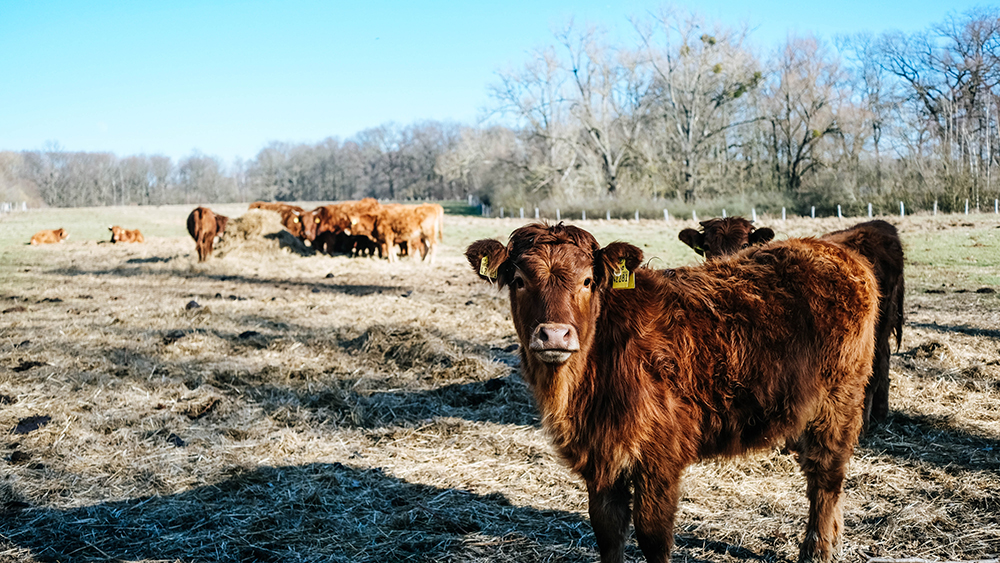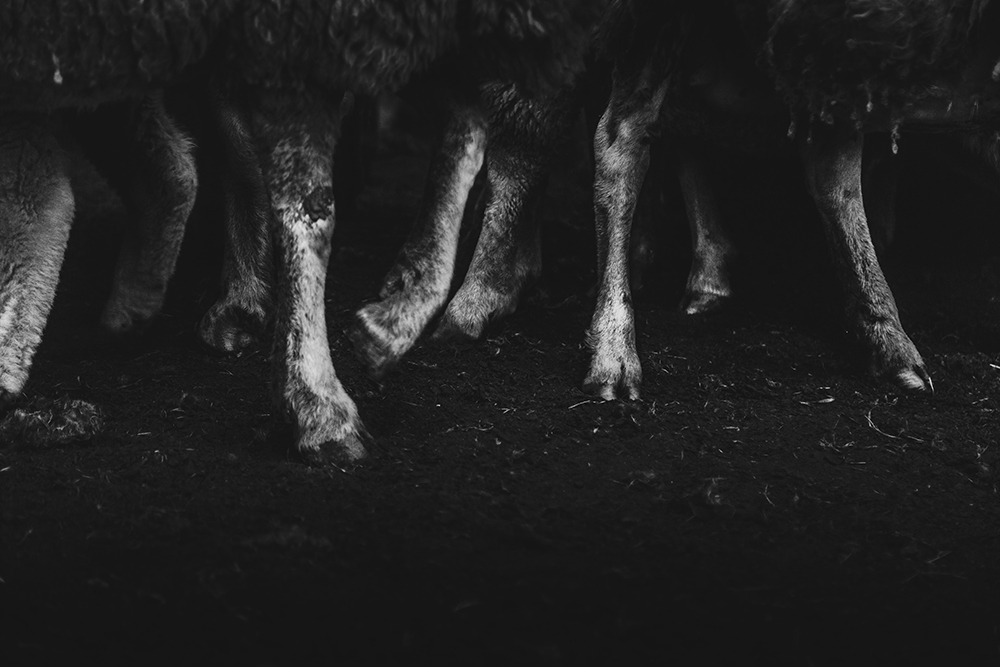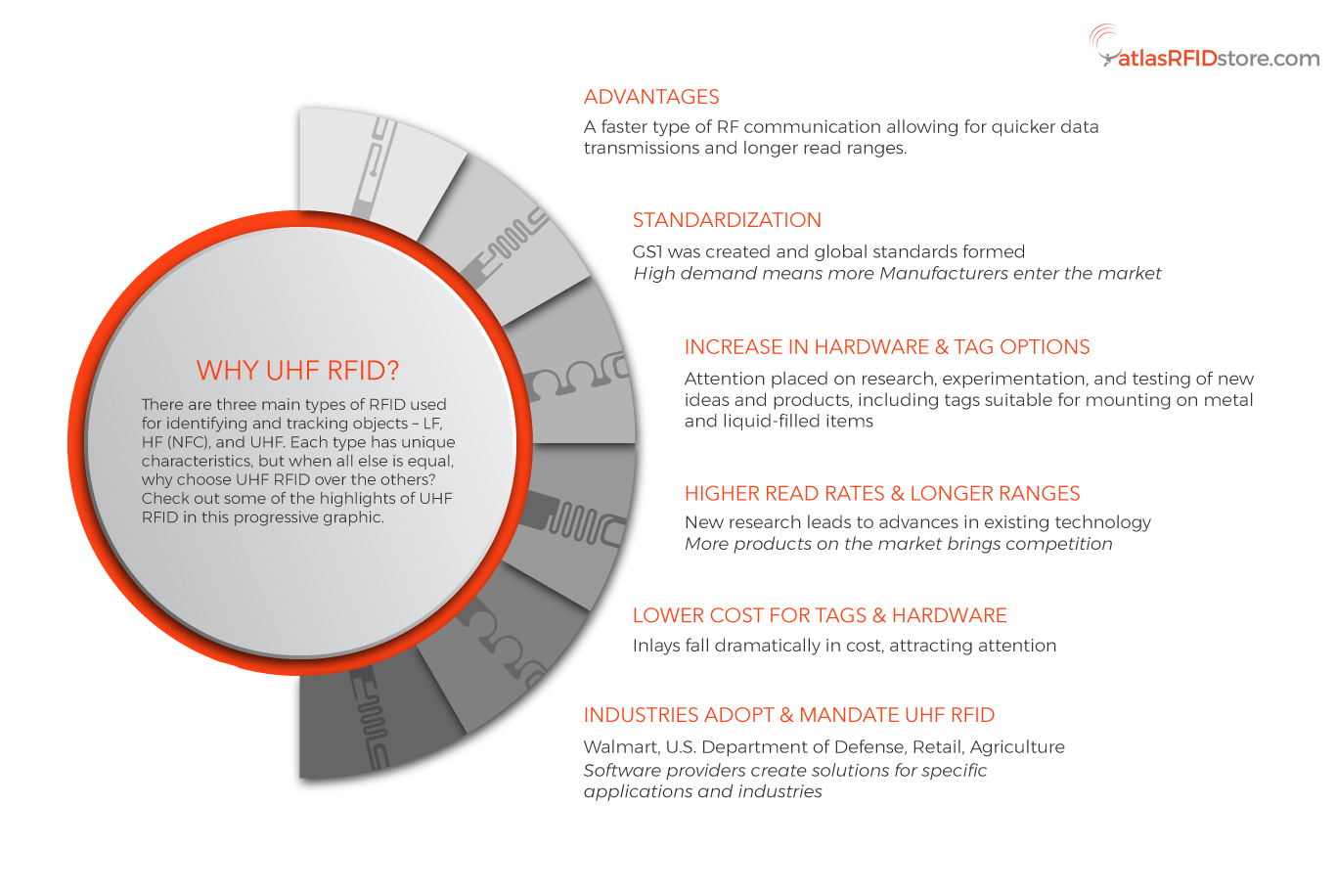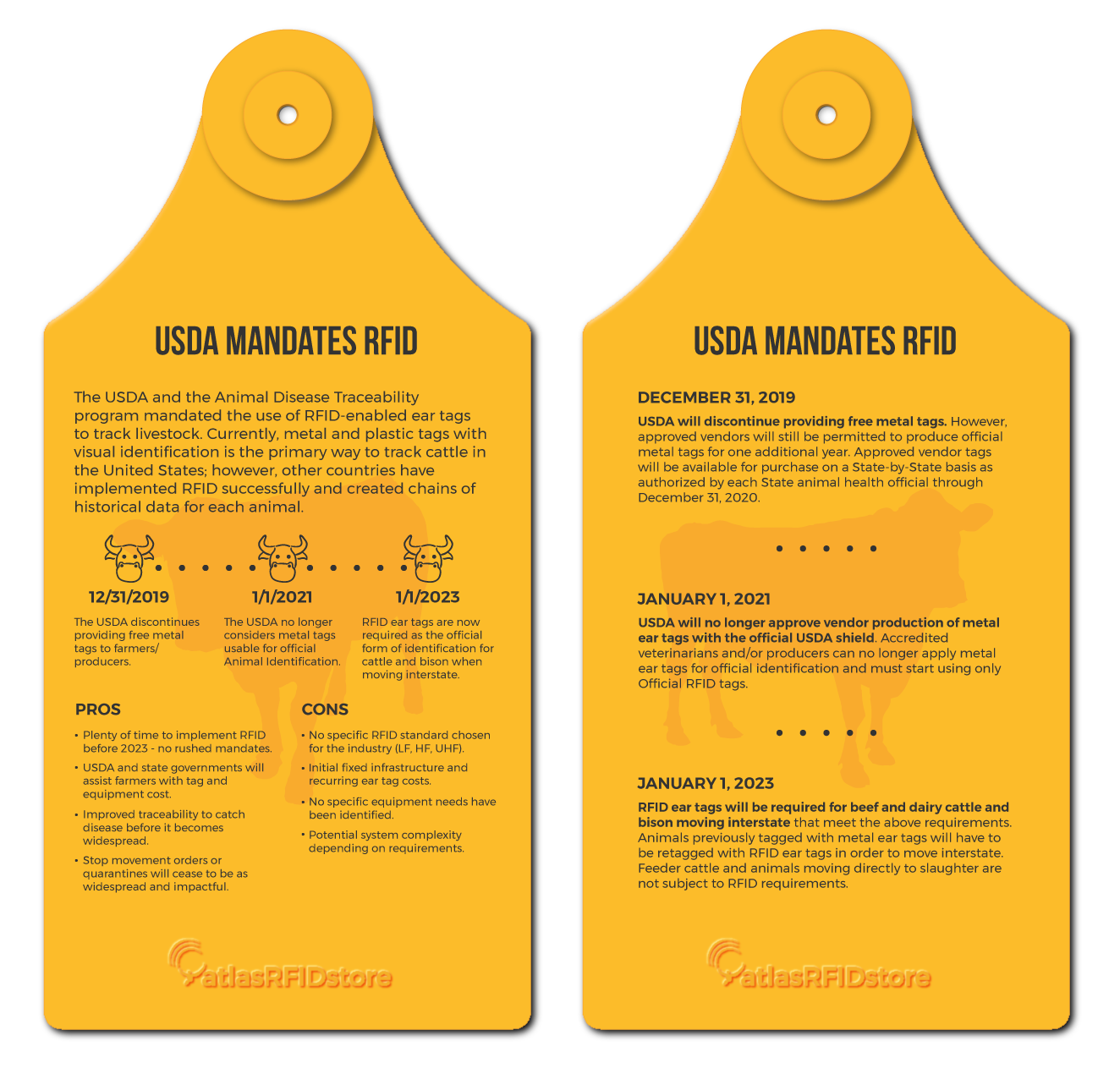USDA Mandates RFID Livestock Tracking
Table of Contents
Cattle Tracking

Tagging an animal with numbered identification has many uses depending on the type of animal, but, generally, it is used for differentiating animals from one another. Both domestic animals and livestock are commonly implanted with a chip, collared, tattooed, or tagged with a plastic or metal plate to identify them visually or electronically.
Individually identifying livestock is essential to managing a herd as it provides a means to uniquely identify a specific animal if one becomes lost or stolen. Additionally, every animal in a herd must be monitored throughout its lifetime. By placing an ear tag on a calf at birth, a farmer can immediately start tracking that individual animal’s specific data. Individual livestock data can include:
- Birth Date
- Mother & Father's ID Numbers
- Genetic Abnormalities
- Gestation Data
- Tattoo/ Herd ID
- Frame Score (height & weight estimates)
- Body Condition (weight & body)
- Sex
- Udder Scores (Udder quality)
- Offspring
- Disease
- Veterinarian Records
Not only is livestock identification important on individual farms, but it is also important when buying, selling, and transporting livestock.
The Problem
Disease
Managing and preventing the spread of disease is, perhaps, the most important aspect of tracking individual livestock. When farmers buy, sell, or trade livestock, cohabitating animals from different environments are at risk for developing or transmitting diseases to the new area – even if they currently do not show symptoms. Common diseases on farms include Foot-and-Mouth Disease, BVD (Bovine Viral Diarrhea), and Bovine tuberculosis, all of which are highly contagious and can spread quickly throughout a herd causing a variety of effects depending on the disease and animal.
Once symptoms begin in one animal, farmers with animals which had contact with that herd can be warned so they can take action and prevent the infection from spreading to other farms. Symptom gestation varies and not all records of buying and selling are kept electronically; because of this, sometimes it takes weeks or even months to identify the cause of a single outbreak. The significance of this time period does not only affect farmers with infected cows or bulls, but all farms within a certain vicinity. When an outbreak occurs, the USDA will place mandatory stop-movement orders or quarantines within a perimeter of the outbreak. If the farms in that area do not have an outbreak, they usually must still abide by the stop-movement order, which means they could lose money by not selling their mature livestock during that time.
Results

While the United States hasn’t had an outbreak of Foot-and-Mouth Disease (FMD) since 1929, fear is still abundant due to the high mobility of livestock. FMD affects divided hoofed animals, like cattle, pigs, deer, and sheep by producing painful blisters that pop and become erosions. Death doesn’t occur in all cases, but the weakening effect on the animal keeps it from producing milk or meat in a normal capacity. The reason that FMD is so feared among Farmers and the USDA is not purely the results of the disease, but the high rate at which it spreads. FMD is severely contagious – in 2001 alone, the U.K had to euthanize over 6 million animals to finally stop the fast-moving epidemic. The 2001 outbreak cost the country around $16 billion and had a staggering effect on both the agriculture and tourism industries.
An epidemic in the U.S. would lead to a halt on all imports and exports of livestock and livestock products until the disease was under control and the livestock and products were deemed safe. In 2017, the USDA estimated the export of U.S. livestock and livestock products, like dairy and meat items, totaled $19 billion alone. The possible devastating effect of another FMD outbreak lead the USDA to create a program to determine and instate preventative steps to lessen the effects of FMD and other contagious diseases.
The Solution
Step One: The ADT Program
The United States Department of Agriculture is the leading authority on all things “food, agriculture, natural resources, rural development, nutrition, and related issues”. Because diseases like FMD can affect millions of livestock and have repercussions on other agriculture products, preventing and containing contagious diseases is a responsibility of the USDA. In response to the growing anxiety of another outbreak similar to the UK, the USDA created the Animal Disease Traceability Program (ADT) in 2013. The creation of the ADT Program began the long-term pursuit of individual animal traceability by starting broadly and enacting regulations for interstate livestock travel. The Program ruled that all livestock moving across state lines must be officially identified and have a Veterinarian Certified Inspection Document before traveling. While this rule doesn’t enforce individual animal traceability specifically, it ensures that all livestock traveling between states are healthy and can be uniquely identified. If an outbreak does occur, this rule allows the USDA to identify if any animals didn’t have their Inspection Documentation and which animals were in the area during the outbreak in order to minimize the effect.
Creating the ADT program and establishing Interstate Traceability rules set the stage to create a larger, more comprehensive network of individual traceability for all livestock.
Step Two: RFID
In 2018, the USDA and the ADT Program took the next step toward the goal of all livestock having 100% traceability from birth to death by implementing a new, electronic system of traceability that starts with eliminating old plastic and metal ear tags. Metal and plastic ear tags are typically very simple and only have a number on them, but can additionally have text, logos, or barcodes as well. Previously provided free from the USDA, metal ear tags have been a standard in the industry for many years. After the elimination of both metal and plastic tags in 2021, they will no longer be accepted as official means of identification; instead, RFID tags will take their place by 2023. All RFID ear tags must be approved by the Animal and Plant Health Inspection Service or APHIS, and all tags must:
- Have an official identification number
- Have the official ear tag shield
- Be tamper evident
- Contain the words “UNLAWFUL TO REMOVE”
Other standards must be adhered to as well, depending on the type of animal, type of tag, and type of numbering scheme. RFID tags have finally come down in price enough for the USDA to acknowledge them as a cost-effective way to make livestock, and even fruits and vegetables, traceable. Moreover, RFID has been used internationally for tracking agriculture for years and other countries want the US to implement similar standards for their livestock and livestock products that are being imported.
Instead of the USDA mandating a specific frequency and RFID tag type, they have left it up to the different industries to decide what works best for them.
RFID Frequency Options
There are three different types of RFID that can be used to track livestock.
- Low-Frequency (LF) RFID tags work well for animal tracking because they are not easily affected by water in an animal’s body. While these tags will be able to be read easier, the read range is limited to only a few inches.
- High-Frequency (HF and NFC) RFID tags can be read up to 1 foot in distance and work relatively well with water in comparison to UHF RFID tags (but, not as well as LF).
- Ultra-High Frequency (UHF) RFID tags have a longer read range than both LF and HF, with an average of 15 to 20 feet (tag dependent), but do not read well in the presence of water. Even though these tags typically do not perform well when tagged directly onto humans and animals, hanging them from the ear of livestock has proven very successful. The USDA created a specific coding scheme for Gen 2 UHF tags for encoding on the EPC memory bank in 2016.
Across the industry, farmers are using all three types RFID tags to identify livestock with success.
What are the Advantages to UHF RFID?

Click Here for Larger, Downloadable Version
While HF and LF have been used for years, the drawbacks of limited range and slow read rates have made farmers and RFID solution providers move towards using UHF RFID. The advantages to UHF RFID over HF and LF include:
- Standardization – UHF Gen2 RFID has worldwide standards, which means that all equipment and tags on the market communicate using the same standard and will work interchangeable (ISO 18000-63).
- Read Range - UHF RFID has the best read range out of the three frequency types, enabling readability from tens of feet (vs. inches).
- Read Rates - Because of UHF’s higher frequency, it allows for faster transmission of data. Most enterprise-level UHF RFID readers can more than several hundred tags per second, making inventorying a herd a quick process.
- Availability of Existing Solutions - The standardization of UHF has made the technology cheaper, more efficient, and led to increased availability, which means that solution providers can easily and cheaply purchase RFID hardware and create a custom solution or product within industries.
Successful RFID Implementations
Because the USDA mandate requires a change in such a large industry, it takes years to plan out how traceability will be achieved, as well as how people affected by this change might respond. The USDA and the ADT Program have been setting the groundwork for widespread change ever since the ADT Program’s installment in 2013. Each small step in the process was a building block – fundamental for the goal of 100% traceability in livestock from birth to death.
From inception, to creation of a plan and timeline, to mandated change in 2013 – the USDA and producers are able to see results from countries, states, and outside programs that have implemented the same RFID initiatives.
- Canada mandated the use of RFID for tracking livestock over 10 years ago in response to a nationwide scare of Mad Cow Disease and have since been using it successfully.
- Australia and New Zealand require certain types of livestock to be tracked via RFID tags in order to prevent the spread of disease and to protect the public.
- In the United States, the state of Michigan has a state-wide mandate that requires livestock to be tracked with RFID tags, which was instated after a scare of Bovine Tuberculosis.
- The National Dairy Expo, a 70,000+ attended event in Wisconsin, also requires all livestock to be tracked with RFID in order to uniquely identify animals and contain the spread of disease.
Timeline and Facts

Click Here for Larger, Downloadable Version
December 31, 2019 USDA will discontinue providing free metal tags. However, approved vendors will still be permitted to produce official metal tags for one additional year. Approved vendor tags will be available for purchase on a State-by-State basis as authorized by each State animal health official through December 31, 2020.
January 1, 2021 USDA will no longer approve vendor production of metal ear tags with the official USDA shield. Accredited veterinarians and/or producers can no longer apply metal ear tags for official identification and must start using only Official RFID tags.
January 1, 2023 RFID ear tags will be required for beef and dairy cattle and bison moving interstate that meet the above requirements. Animals previously tagged with metal ear tags will have to be retagged with RFID ear tags in order to move interstate. Feeder cattle and animals moving directly to slaughter are not subject to RFID
The length of the timeline allows for a gradual, phased transition to replace all current ear tags with electronic tags. Here are some facts about the mandate:
Facts
- Metal ear tags will not be provided after 12/31/2019.
- Metal ear tags will no longer be produced after 1/1/2021.
- Metal ear tags cannot be used as official identification after 1/1/2021.
- RFID ear tags will be required as official identification after 1/1/2023.
- Animals covered under this mandate include:
- Beef Cattle & Bison that are either – sexually intact and 18 months or older, used for rodeo or recreational events at any age, and used for exhibition and event.
- Dairy Cattle that are either – Female cattle, or Male cattle born after 3/11/2013.
- The type of RFID frequency depends on the state, producer, or industry.
- All RFID ear tags must be approved by the USDA.
- All RFID ear tags must meet standards for quality and performance, be tamper proof, contain a unique ID, and display the U.S. official ear tag shield.
- RFID ear tags must contain visual identification, such as the ID number and official ear tag shield.
- RFID ear tags should be attached at time of birth or before interstate travel.
- The USDA and State governments have agreed to work together to share some of the cost of RFID ear tags to lessen the burden on farmers/producers.
- The USDA and State governments have agreed to work together to provide funding for RFID readers/systems for markets and certified veterinarians.
- The USDA is planning to improve current government systems for RFID tag distribution, tracking, and record keeping.
- The USDA is planning to provide support during the transition to RFID tagging.
Click Here for the Larger, Downloadable Version
Implementation & Capabilities
A Network of Data
The USDA’s vision is to tag livestock with RFID tags at birth by the producer or a certified veterinarian. Each tag will have a unique number encoded specifically for that animal that identifies the state, the animal’s unique identification number, and also can have a herd management number. Currently, a few different USDA approved animal numbering systems are available that can be used to create each animal’s unique identification number such as:
- Animal Identification Number (AIN)
- National Uniform Ear-tagging System (NUES) – 9
- National Uniform Ear-tagging System (NUES) – 8
- Flock-based Number
- Location-based Number
- USDA approved Backtag
Once the animal is given an RFID ear tag, a certified veterinarian can update a database to include the animal’s unique identification number and information such as the Owner’s Name, Address, City, State, Zip Code, and Phone Number. Throughout the animal’s life, certified veterinarians and officials can scan the animal’s ear tag and keep updated records on an associated database.
When animals move interstate, the owner can send the USDA official moving information, including which ID numbers are moving and where they are moving. By capturing this data, the movement of these animals can be documented in the system and, in case of a disease outbreak, they can be quarantined.
RFID Capabilities
Tagging each animal electronically with RFID, opens many possibilities, not only for the USDA and the states, but also for individual producers/farmers. Below are a few applications that that can be implemented once RFID ear tags are in place.
Animal Authentication
During the buying, selling, and trading of livestock, it is important to ensure that the agreed upon animal is the one that is received. Livestock value is dependent upon factors such as frame size, weight, sex, and/or value of production; so, if a predetermined monetary value of an animal is exchanged and the animal received is not the one that is agreed upon, producers lose money. Authenticity can be guaranteed during a transaction by scanning the animal’s official, tamper-proof RFID ear tag and receiving records from a national database.
Individual Animal Locating
If a specific animal is pregnant, hurt, or sick and needs to be located, it’s unique ID number can be entered into a handheld RFID reader and the Geiger Counter functionality can be used to find the animal in a large herd. This can be a useful, time-saving measure especially for farmers with large herds or expansive pastures. The Southern Alberta Institute of Technology (SAIT) is working on a project using RFID-enabled drones to successfully locate cows that have been separated from the herd to ensure the animal(s) are alive and well without expending resources to locate them on thousands of acres.
Access Control
Common access control applications are deployed in hospitals, hotels, or gated lots, but the same concept can be used for cow pastures or barn access. If livestock is directed through a chute or funnel, an RFID reader can read each RFID ear tag and, in conjunction with software, sort an individual animal into a specific pasture or building. A platform with an RFID-enabled auto sorter could be effective for sorting males and females, pregnant females from the herd, or by a host of other qualifications like genetics, weight, etc.
Chain of Custody
Tying scans of RFID ear tags to owner information can create a chain of custody. These records could be leveraged when buying livestock from auction, and in cases when a purchased animal is found to have been mistreated, malnourished, or treated with illegal drugs. In such cases, the previous owner or company can be investigated and possibly charged with animal cruelty or neglect. Chain of custody records could also be useful for breeding purposes – e.g. contacting an animal’s breeder to learn about any genetic defects associated with the lineage.
Data & Record Keeping
Ensuring that each animal in a herd is taken care of and receives proper nutrition, vaccinations, and treatment is incredibly important to producers. One of the dangers of vaccinating livestock is over or under dosing an animal. Under dosing is wasted money because it does not protect the animal from the disease and can result in the animal building up a resistance to the vaccine. In a dairy cow’s average lifetime of 4 years, they could receive 20+ vaccinations depending on the region and animal, which equates to 20+ chances of over or under dosing per animal. To help with this issue, a system was developed that weigh each animal, calculate and load the specific dose of medicine into a dosing gun to administer to the animal, and uses integrated RFID technology to capture and record the animal’s ID number.
Keeping records of owner information and veterinary information can be integral for herd maintenance. Based on averages and genetics, each animal should maintain an average weight and size depending on age; however, if there aren’t accurate records of growth rates for each animal, it may be difficult to accurately gauge if they are receiving the proper nutrition. The Frame Score of Beef Cattle is an important metric that is created by skeletal size of an animal and using that to predict the height and weight of the mature animal. It is important to keep track of the frame score and how the animal is maturing to properly forecast body condition and weight when the animal is taken for slaughter. Keeping track of weight, height, and body condition daily or weekly leads to better predictions of the health of the cow and helps to determine it’s worth at maturity.
One rancher, Louis Dubs, commented about the usefulness of RFID for data and recordkeeping: “I can easily tell which animals are performing and which animals are not, and information is valuable, even in ranching. With that data I can change breeding programs and remove certain animals who are underperforming”.
What's Next?
While some farmers/producers have already implemented RFID both in the US and around the world, the USDA mandate will not require RFID ear tags until 2023. If you have not yet implemented RFID, but are required to, there are a few things to think about before jumping straight in.
-
Determine your business needs and problem areas that you’d like to address – such as managing records, locating livestock, collecting and maintaining veterinary data, or over or under dosing livestock.
Why? If you have no issues with herd management or need for any applications referenced above, simply changing to a new ear tag that’s RFID enabled could be sufficient.
However, if you have some processes that just are not efficient and effective or there are some gaps you’d like to fill in terms of missing data, it is best to look into RFID solutions before you determine an RFID frequency type. For example, if you purchase thousands of LF RFID ear tags, but later want to implement an access control system, that might not be feasible because of the read range limitations associated with LF RFID.
-
Once you have listed out your needs and/or problems that you currently experience, research the problems/solutions and call an RFID expert to discuss which type of RFID solution would be best for your business. From there, hardware and tag needs can be identified, system requirements can be scoped, and a quote can be provided.
Why? It’s best to research and receive price quotes on the capabilities and the hardware needed before you begin trying to implement the technology. It could be that one or more of the desired applications is not cost feasible to implement, gathering estimates allows you to perform an ROI analysis.
-
Determine the overall cost that would go into setting up the system(s) and, if possible, determine the Return on Investment (ROI) in order to ensure that an RFID system will save you time and money. Some applications might provide a clearer ROI, like if you had records of under-dosed animals or animals with lost or mis-managed records.
Why? Before spending time and effort in choosing and deploying a new technology, it is always wise to see what the current management system is costing in terms of money and time. All costs affect the bottom line; so, companies must provide a valuable case for change.
-
If you decide to implement more than one system to solve existing problems, remember that not all hardware and software have to be purchased and implemented at once. It’s easier to start with tagging the animals and then create a timeline for deploying RFID systems over the course of months or years. As a reminder, RFID tag selection (LF, HF, or UHF) at the outset will, ultimately, determine the capability of your system; so, your future business needs should guide your tag selection from day one.
Why? Common issues with any type of change derive from not understanding the scope of the project or taking on too much at once. Use the crawl – walk – run principle to step your way through this process.
-
Research pre-existing RFID solutions on the market and the prices associated with them. Implementing a complete, finished solution could solve potential headaches that a do-it-yourself (DIY) system might cause. You can also research herd management software or other data applications and talk to the company about integrating their pre-existing software with an RFID hardware system.
Why? If there is a pre-existing system or easy-to-integrate software, it could make the project easier and quicker to implement. Also, if it is a system that has been previously deployed, the system provider might know of any potential issues that could be encountered.
-
Talk to industry officials and other farmers/producers in your area about what their plans are as far as determining which RFID frequency type that will work best for them.
Why? Others affected by the new mandate might have differing opinions or have already implemented an RFID system and may have helpful advice on the process.
Want to Learn More?
atlasRFIDstore has been providing RFID equipment, solutions, and education since 2008 to companies around the world. Checkout some of our most popular eBooks to learn RFID Basics, Types of RFID, and information on individual RFID equipment like RFID Readers and RFID Tags. If you have any questions, feel free to contact us.
